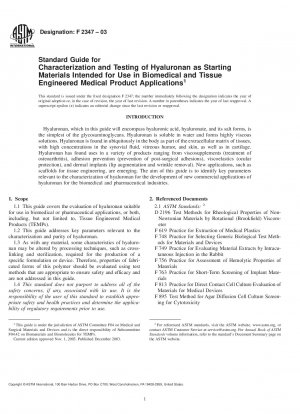ASTM F2347-03
Standard Guide for Characterization and Testing of Hyaluronan as Starting Materials Intended for Use in Biomedical and Tissue Engineered Medical Product Applications
- Standard No.
- ASTM F2347-03
- Release Date
- 2003
- Published By
- American Society for Testing and Materials (ASTM)
- Status
- Replace By
- ASTM F2347-11
- Latest
- ASTM F2347-15
- Scope
This guide contains a listing of those characterization parameters that are directly related to the functionality of hyaluronan. This guide can be used as an aid in the selection and characterization of the appropriate hyaluronan for a particular application. This guide is intended to give guidance in the methods and types of testing necessary to properly characterize, assess, and ensure consistency in the performance of a particular hyaluronan. It may have use in the regulation of these devices by appropriate authorities.
The hyaluronan covered by this guide may be gelled, cross-linked, extruded, or otherwise formulated into biomedical devices for use in tissue engineered medical products or drug delivery devices for implantation as determined to be appropriate, based on supporting biocompatibility and physical test data. Recommendations in this guide should not be interpreted as a guarantee of clinical success in any tissue engineered medical product or drug delivery application.
To ensure that the material supplied satisfies requirements for use in TEMPs, several general areas of characterization should be considered. These are: identity of hyaluronan, physical and chemical characterization and testing, impurities profile, and performance-related tests.
1.1 This guide covers the evaluation of hyaluronan suitable for use in biomedical or pharmaceutical applications, or both, including, but not limited to, Tissue Engineered Medical Products (TEMPs).
1.2 This guide addresses key parameters relevant to the characterization and purity of hyaluronan.
1.3 As with any material, some characteristics of hyaluronan may be altered by processing techniques, such as cross-linking and sterilization, required for the production of a specific formulation or device. Therefore, properties of fabricated forms of this polymer should be evaluated using test methods that are appropriate to ensure safety and efficacy and are not addressed in this guide.
1.4 This standard does not purport to address all of the safety concerns, if any, associated with its use. It is the responsibility of the user of this standard to establish appropriate safety and health practices and determine the applicability of regulatory requirements prior to use.
ASTM F2347-03 Referenced Document
- ASTM D2196 Standard Test Methods for Rheological Properties of Non-Newtonian Materials by Rotational (Brookfield type) Viscometer
- ASTM F1251 Standard Terminology Relating to Polymeric Biomaterials in Medical and Surgical Devices
- ASTM F1439 Standard Guide for Performance of Lifetime Bioassay for the Tumorigenic Potential of Implant Materials
- ASTM F1903 Standard Practice for Testing for Biological Responses to Particles In Vitro
- ASTM F1904 Standard Practice for Testing the Biological Responses to Particles In Vivo
- ASTM F1905 Standard Practice for Selecting Tests for Determining the Propensity of Materials to Cause Immunotoxicity
- ASTM F1906 Standard Practice for Evaluation of Immune Responses In Biocompatibility Testing Using ELISA Tests, Lymphocyte, Proliferation, and Cell Migration
- ASTM F619 Standard Practice for Extraction of Medical Plastics
- ASTM F748 Standard Practice for Selecting Generic Biological Test Methods for Materials and Devices
- ASTM F749 Standard Practice for Evaluating Material Extracts by Intracutaneous Injection in the Rabbit
- ASTM F756 Standard Practice for Assessment of Hemolytic Properties of Materials
- ASTM F763 Standard Practice for Short-Term Screening of Implant Materials
- ASTM F813 Standard Practice for Direct Contact Cell Culture Evaluation of Materials for Medical Devices
- ASTM F895 Standard Test Method for Agar Diffusion Cell Culture Screening for Cytotoxicity
- ASTM F981 Standard Practice for Assessment of Compatibility of Biomaterials for Surgical Implants with Respect to Effect of Materials on Muscle and Bone
- ISO 10993 Biological evaluation of medical devices — Part 9: Framework for identification and quantification of potential degradation products
- ISO 10993-1 Biological evaluation of medical devices - Part 1: Evaluation and testing within a risk management process
- ISO 10993-7 Biological evaluation of medical devices - Part 7: Ethylene oxide sterilization residuals; Technical Corrigendum 1
- ISO 10993-9 Biological evaluation of medical devices — Part 9: Framework for identification and quantification of potential degradation products
- ISO 14160:1998 Sterilization of single-use medical devices incorporating materials of animal origin - Validation and routine control of sterilization by liquid sterilants
ASTM F2347-03 history
- 2015 ASTM F2347-15 Standard Guide for Characterization and Testing of Hyaluronan as Starting Materials Intended for Use in Biomedical and Tissue Engineered Medical Product Applications
- 2011 ASTM F2347-11 Standard Guide for Characterization and Testing of Hyaluronan as Starting Materials Intended for Use in Biomedical and Tissue Engineered Medical Product Applications
- 2003 ASTM F2347-03 Standard Guide for Characterization and Testing of Hyaluronan as Starting Materials Intended for Use in Biomedical and Tissue Engineered Medical Product Applications
